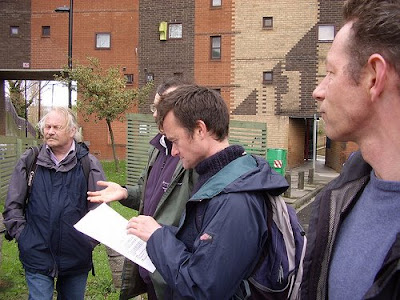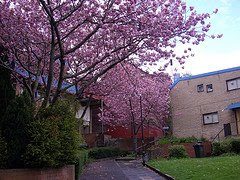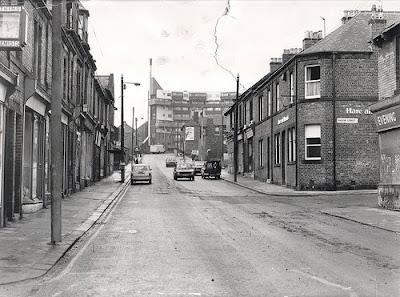Home to the fans of humanist modernism
Friday 24 October 2008
Saturday 1st November 2008
This is the date for our next event - tidying up, weeding and planting a garden at Bolam Coyne. Hopefully some leaf collection too for our allotments!
Saturday 1st November 2008
This is the date for the next event organised by us in the Estate. We are heading to Bolam Coyne (a fantastic group of houses and flats) that has been left empty and derelict since 2000. We are going to do some tidying up and planting up of one of the gardens. It really is a fantastic piece of urban design and with a cultivated garden it will just be amazing! Watch out for the photographs...
Saturday 11 October 2008
Things are hotting up in October!
Plans and strategies are really coming along grand with the Society. We are running an event at Bolam Coyne in November to get us locals involved in looking after the place - one of the finest pieces of 20th century housing in Europe.
Watch this space!
Watch this space!
Thursday 1 May 2008
Byker Redevelopment Walk: Trees


Today we had our first walkabout. It was arranged to coincide with the superb cherry blossom display we have at this time of year. Seamus Tollitt, Walker Park Manager and myself led the walk: I did a bit on the architectural context and Seamus give us all sorts of information about trees and how to identify them.
We covered a tiny section of the estate and the walk took 1.5 hours! We identified: Scots pine, beech, ash, holly, poplar, cherry, silver birch, leylandii, acers, lime, alder and elm.
About 12 people came along and joined in. It rained just before the start, dried up and the last part was in glorious sunshine - which sets Byker off to perfection!
We covered a tiny section of the estate and the walk took 1.5 hours! We identified: Scots pine, beech, ash, holly, poplar, cherry, silver birch, leylandii, acers, lime, alder and elm.
About 12 people came along and joined in. It rained just before the start, dried up and the last part was in glorious sunshine - which sets Byker off to perfection!
A success!
Hare and Hounds For Sale

The Hare and Hounds pub - one of the original 'community' facilities from Old Byker - is now closed (hurray! because it was a right charva dive). What can we do with it? A good restaurant/cafe/etc?
This is a photograph taken in 1975 looking up Raby Street towards Rabygate. The Hare and Hounds is on the right.
Talking of 'The Byker Phoenix'
I guess it would be good if The Ralph Erskine Society had a web based newsletter. This could cover the residents of ALL of his developments.
But it would also be good to have a local newsletter for The Byker Redevelopment, written and produced by residents. This could be the new Byker Phoenix. Cool, eh? Will have to think more of this and have a look at the old ones to see what kind of thing they covered. How often could be produce one? Say every 2 months? What's happening in Byker, what groups are active, housing issues, environment, all those local things.
But it would also be good to have a local newsletter for The Byker Redevelopment, written and produced by residents. This could be the new Byker Phoenix. Cool, eh? Will have to think more of this and have a look at the old ones to see what kind of thing they covered. How often could be produce one? Say every 2 months? What's happening in Byker, what groups are active, housing issues, environment, all those local things.
Meeting more people...
I was at Marilyn Charlton's leaving do yesterday. She has been the Byker Co-ordinator for several years so has developed many links within the community. So of course there were plenty of people there - and didnt have time to eat because I was too busy talking. There are so many people with such good strories to tell and so I collected more contact details. Also met up with Peggy who lives next to the Hairdressers on Raby Street. She was keen for something to happen in there so that was a good sign. And one of the group HAS A COMPLETE COLLECTION OF THE 'BYKER PHOENIX'! How amazing is that. I am planning to get it digitized.
Oh, also met up with Sirkka Liisa Kottinen to chat about having a photo taken as part of her current project on Byker. Its good to talk with interesting people with different experiences.
Oh, also met up with Sirkka Liisa Kottinen to chat about having a photo taken as part of her current project on Byker. Its good to talk with interesting people with different experiences.
Monday 28 April 2008
More implications of listing
Advice for Owners of Listed Buildings
Owners have the most important role in looking after historic buildings, and many take great pride in the care of their property and in preserving its character and atmosphere. Local authorities can provide a first level of advice if changes are needed, and can alert English Heritage to any cases where our involvement may be necessary.
When do I need listed building consent?
You will need to get listed building consent from your local council if you want to demolish a listed building or any part of it, or alter it in any way which would affect its character, inside or out. Repairs which match exactly may not need consent, but your local council will advise you on this as the effect of any repairs is not always straightforward. Examples of work which may need consent include changing windows and doors, painting over brickwork or removing external surfaces, putting in dormer windows or rooflights, putting up aerials, satellite dishes and burglar alarms, changing roofing materials, moving or removing internal walls, making new doorways, and removing or altering fireplaces, panelling or staircases.
How do I apply for listed building consent?
Your first step should be to contact your local council before you make the application. The conservation officer will tell you whether your proposals are likely to be accepted. This could save you time and money. It is often best to employ an architect who is used to working with listed buildings. Local authorities deal with all listed building consent cases and will give you the appropriate form for making your application. The majority of cases are dealt with by the local authority, but the most important cases are referred to English Heritage (Notifications) and sometimes to the Secretary of State for the Environment, Transport and the Regions (Referrals). Your application will need to include enough information to show clearly what you intend to do, with detailed drawings and photographs.
How long will it take?
It will usually take at least eight weeks after you send in your application form for a decision to be sent to you. If consent is refused you have six months in which you can appeal to the Department of the Environment, Transport and the Regions.
What happens if I make alterations without consent?
Carrying out unauthorised work to a listed building is a criminal offence punishable by a fine or a prison sentence and the local council can require you to put the building back as it was.
What is the VAT position?
VAT does not apply to the cost of alterations to listed buildings, although it does apply to repairs and ordinary maintenance. For more detail see the leaflet VAT: Protected buildings (708/1/90), available from VAT offices.
Owners have the most important role in looking after historic buildings, and many take great pride in the care of their property and in preserving its character and atmosphere. Local authorities can provide a first level of advice if changes are needed, and can alert English Heritage to any cases where our involvement may be necessary.
When do I need listed building consent?
You will need to get listed building consent from your local council if you want to demolish a listed building or any part of it, or alter it in any way which would affect its character, inside or out. Repairs which match exactly may not need consent, but your local council will advise you on this as the effect of any repairs is not always straightforward. Examples of work which may need consent include changing windows and doors, painting over brickwork or removing external surfaces, putting in dormer windows or rooflights, putting up aerials, satellite dishes and burglar alarms, changing roofing materials, moving or removing internal walls, making new doorways, and removing or altering fireplaces, panelling or staircases.
How do I apply for listed building consent?
Your first step should be to contact your local council before you make the application. The conservation officer will tell you whether your proposals are likely to be accepted. This could save you time and money. It is often best to employ an architect who is used to working with listed buildings. Local authorities deal with all listed building consent cases and will give you the appropriate form for making your application. The majority of cases are dealt with by the local authority, but the most important cases are referred to English Heritage (Notifications) and sometimes to the Secretary of State for the Environment, Transport and the Regions (Referrals). Your application will need to include enough information to show clearly what you intend to do, with detailed drawings and photographs.
How long will it take?
It will usually take at least eight weeks after you send in your application form for a decision to be sent to you. If consent is refused you have six months in which you can appeal to the Department of the Environment, Transport and the Regions.
What happens if I make alterations without consent?
Carrying out unauthorised work to a listed building is a criminal offence punishable by a fine or a prison sentence and the local council can require you to put the building back as it was.
What is the VAT position?
VAT does not apply to the cost of alterations to listed buildings, although it does apply to repairs and ordinary maintenance. For more detail see the leaflet VAT: Protected buildings (708/1/90), available from VAT offices.
Implications of Listing a Building...part 1.
As you may know the Byker Redevelopment is a 'listed' English social housing estate. I have just taken this from the English Heritage website. Please note the text highlighted in RED:
What Does Listing Mean?
Why do we list? The word 'listing' is a short-hand term used to describe one of a number of legal procedures which help English Heritage to protect the best of our architectural heritage. When buildings are listed they are placed on statutory lists of buildings of 'special architectural or historic interest' compiled by the Secretary of State for Culture, Media and Sport under the Planning (Listed Buildings and Conservation Areas) Act 1990, on advice from English Heritage.
Listing is not intended to fossilise a building.
A building's long-term interests are often best served by putting it to good use, and if this cannot be the one it was designed for, a new use may have to be found.
Listing ensures that the architectural and historic interest of the building is carefully considered before any alterations, either outside or inside, are agreed.
Why are buildings chosen?
We select listed buildings with great care. The main criteria used are:
architectural interest: all buildings which are nationally important for the interest of their architectural design, decoration and craftsmanship; also important examples of particular building types and techniques, and significant plan forms
historic interest: this includes buildings which illustrate important aspects of the nation's social, economic, cultural or military history , close historical association with nationally important buildings or events, group value, especially where buildings comprise an important architectural or historic unity or are a fine example of planning (such as squares, terraces and model villages)
The older and rarer a building is, the more likely it is to be listed. All buildings built before 1700 which survive in anything like their original condition are listed, as are most built between 1700 and 1840. After that date, the criteria become tighter with time, because of the increased number of buildings erected and the much larger numbers which have survived, so that post-1945 buildings have to be exceptionally important to be listed. Buildings less than 30 years old are only rarely listed, if they are of outstanding quality and under threat.
See See post-war listing.
Why are there three grades?
Listed buildings are graded to show their relative importance:
Grade I buildings are those of exceptional interest.
Grade II* are particularly important buildings of more than special interest
Grade II are of special interest, warranting every effort to preserve them.
There are 370,000 or so list entries currently protected by listing, and of those by far the majority - over 92% - are Grade II. Grade I and II* buildings may be eligible for English Heritage grants for urgent major repairs.
So looking at this The Byker Redevelopment is considered 'exceptionally important', 'outstanding quality' and in the top 8% of those buildings that have been listed in England.
Quite amazing really.
What Does Listing Mean?
Why do we list? The word 'listing' is a short-hand term used to describe one of a number of legal procedures which help English Heritage to protect the best of our architectural heritage. When buildings are listed they are placed on statutory lists of buildings of 'special architectural or historic interest' compiled by the Secretary of State for Culture, Media and Sport under the Planning (Listed Buildings and Conservation Areas) Act 1990, on advice from English Heritage.
Listing is not intended to fossilise a building.
A building's long-term interests are often best served by putting it to good use, and if this cannot be the one it was designed for, a new use may have to be found.
Listing ensures that the architectural and historic interest of the building is carefully considered before any alterations, either outside or inside, are agreed.
Why are buildings chosen?
We select listed buildings with great care. The main criteria used are:
architectural interest: all buildings which are nationally important for the interest of their architectural design, decoration and craftsmanship; also important examples of particular building types and techniques, and significant plan forms
historic interest: this includes buildings which illustrate important aspects of the nation's social, economic, cultural or military history , close historical association with nationally important buildings or events, group value, especially where buildings comprise an important architectural or historic unity or are a fine example of planning (such as squares, terraces and model villages)
The older and rarer a building is, the more likely it is to be listed. All buildings built before 1700 which survive in anything like their original condition are listed, as are most built between 1700 and 1840. After that date, the criteria become tighter with time, because of the increased number of buildings erected and the much larger numbers which have survived, so that post-1945 buildings have to be exceptionally important to be listed. Buildings less than 30 years old are only rarely listed, if they are of outstanding quality and under threat.
See See post-war listing.
Why are there three grades?
Listed buildings are graded to show their relative importance:
Grade I buildings are those of exceptional interest.
Grade II* are particularly important buildings of more than special interest
Grade II are of special interest, warranting every effort to preserve them.
There are 370,000 or so list entries currently protected by listing, and of those by far the majority - over 92% - are Grade II. Grade I and II* buildings may be eligible for English Heritage grants for urgent major repairs.
So looking at this The Byker Redevelopment is considered 'exceptionally important', 'outstanding quality' and in the top 8% of those buildings that have been listed in England.
Quite amazing really.
Heritage Open Days, September 2008
I've been thinking about what to arrange for HoD in September:
- exploring the common heritage of Erskine's developments
- linking groups who live in Byker
- a series of special activities and events
- doing a guided tour leaflet for The Byker Redevelopment
- putting on a photographic exhibition with links to flickr and these blogs
- other things!
Just a thought...
As I have been on the trail of Erskine archive material from the 60s and 70s concerning the Byker Redevelopment, it has made me think...
... there is so much 'regeneration' going on in this country: now they are 'redeveloping' the Redevelopment. So what went wrong?
... there is so much 'regeneration' going on in this country: now they are 'redeveloping' the Redevelopment. So what went wrong?
Friday 25 April 2008
Erskine Archive

Today I visited George Tullin, Planning Support at the Civic Centre. He showed me what he has with regard to images of the Byker Redevelopment before, during and after construction. Some spectacular images, one of which is shown here. Please remember it is copyright of Newcastle City Council.
I think that there is a lot of information out there - its just a matter of tracking it down. People seem keen to help too, which helps.
I think that there is a lot of information out there - its just a matter of tracking it down. People seem keen to help too, which helps.
Tuesday 22 April 2008
WELCOME
This blog has been set up to promote debate and discussions around the work of this Anglo-Swedish architect. Please keep visiting to see what the debates are and to contribute your opinions.
Subscribe to:
Posts (Atom)
